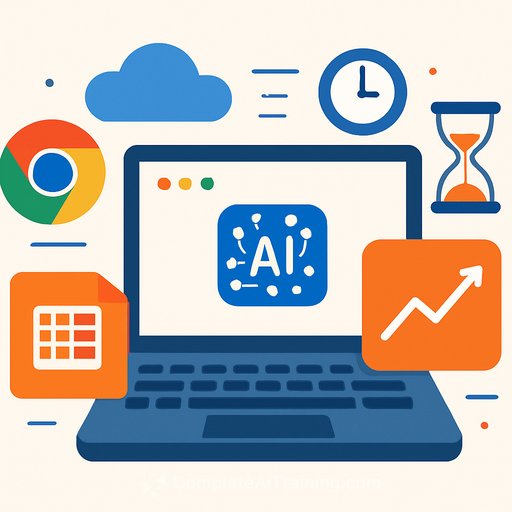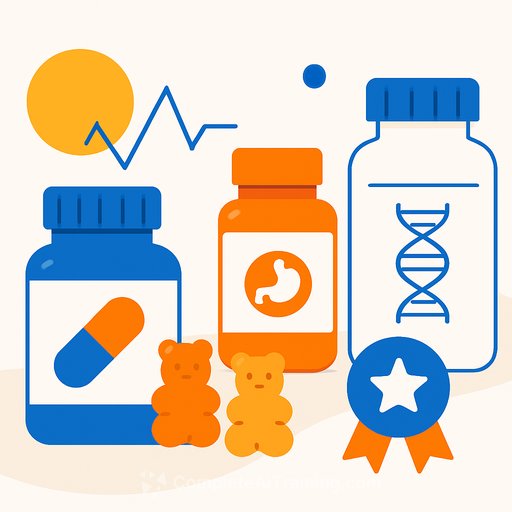Anthropic Opus 4.5: Chrome and Excel AI that moves product work forward
Anthropic's Opus 4.5 closes the 4.5 series with browser and spreadsheet integrations built for daily work. Paired with stronger memory and top-tier benchmark results, it's geared for teams that ship software and need faster research, cleaner analysis, and tighter execution. If you've been waiting for AI that fits inside the tools you already use, this is worth a look.
Why this matters for product development
- Faster discovery: summarize specs, RFCs, and competitor pages without tab-hopping.
- Cleaner analysis: automate Excel formulas, charts, and model sanity checks.
- Deeper context: keep long-running discussions moving across docs, code, and data.
- Stronger delivery: coordinate multi-step tasks with agent-style workflows.
What's new in Opus 4.5
- SWE-Bench verified: first model above 80%.
- Terminal-bench: state-of-the-art coding performance.
- tau2-bench and MCP Atlas: advanced tool use.
- ARC-AGI 2 and GPQA Diamond: improved problem-solving depth.
Claude Chrome integration: your AI in the page you're viewing
The Claude Chrome integration brings context-aware help to the current tab for Max users. You get analysis and suggestions that respect on-page content, so you can review a PRD, spec, or competitor teardown and ask pointed questions without switching apps.
- Seamless browsing: ask, summarize, or draft within the page you're on.
- Real-time analysis: extract key points, risks, and open questions from long reads.
- Context-aware responses: fewer "copy/paste" loops, more focused decisions.
Practical uses: feature brief drafts from call notes, VOC synthesis from review pages, and instant reference checks against your public docs.
Excel AI: fewer manual steps, more reliable analysis
Available to Max, Team, and Enterprise users, the Excel integration handles the work most teams do by hand. Formulas, charts, and pattern detection become prompts-not an afternoon of cell wrangling.
- Advanced data analysis and visualization with guided prompts.
- Automated formula generation and optimization for complex sheets.
- Pattern recognition to spot anomalies and trends in large datasets.
- Works inside existing workflows-no migration required.
Use cases: cohort retention breakdowns, prioritization scoring, pricing experiments, funnel diagnostics, capacity planning, and quick QC on data pulls.
Memory that supports long-context work
Opus 4.5 improves what the model remembers and when it chooses to recall it. As Dianne Na Penn, Anthropic's head of product management for research, notes: "Knowing the right details to remember is really important in complement to just having a longer context window. This is where fundamentals like memory become really important because Claude needs to be able to explore code bases and large documents, and also know when to backtrack and recheck something."
Endless chat for paid users
- Conversations continue beyond typical context limits.
- Automatic context compression in the background.
- Smoother handling of long documents and codebases.
- Fewer resets, more continuity across workstreams.
Agentic use-cases: Opus as lead, Haiku as specialists
Opus 4.5 is built to coordinate sub-agents, with Haiku handling focused tasks. That means complex work can be split, tracked, and recombined without manual orchestration.
- Task decomposition for multi-part projects and research sprints.
- Resource allocation across agents for speed and cost control.
- Collaborative problem-solving on enterprise-scale workflows.
- Examples: release readiness checks, incident retros, vendor comparisons, and multi-source research pipelines.
Benchmarks at a glance
- SWE-Bench verified: >80% (first to cross that bar).
- Terminal-bench: state-of-the-art coding performance.
- Tool use benchmarks: leading performance for practical applications.
Competitive view
Opus 4.5 goes head-to-head with OpenAI's GPT 5.1 and Google's Gemini 3. The difference here is the blend of memory improvements, in-browser support, and Excel integration, which maps cleanly to product and engineering workflows inside companies.
Implementation checklist for product teams
- Access: enable the Chrome extension for Max users; turn on Excel integration for Max, Team, and Enterprise.
- Pick two workflows to pilot: e.g., competitor reviews in Chrome and sprint analytics in Excel.
- Define guardrails: data handling, review steps, and output acceptance criteria.
- Measure outcomes: hours saved, PRD cycle time, defect discovery, and analysis accuracy.
- Scale with agents: let Opus coordinate Haiku sub-agents for research and QA loops.
FAQs
Who's leading model development right now?
Anthropic, OpenAI, and Google DeepMind are the primary players.
Who's driving product strategy at Anthropic?
Dianne Na Penn leads product management for research.
Which investors back AI innovation?
Firms like Andreessen Horowitz (a16z) continue to fund category growth.
Where do models and collaborations live?
Hugging Face hosts model sharing and community work, while cloud providers supply the infrastructure.
Learn more
Bottom line
Opus 4.5 points to an integrated future: AI that lives where the work happens and keeps context over time. With Chrome and Excel support, stronger memory, and agent coordination, product teams get a clearer path from research to decision to delivery-without extra process overhead.
Your membership also unlocks:






